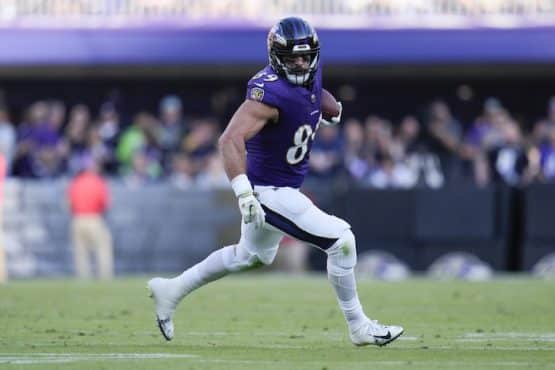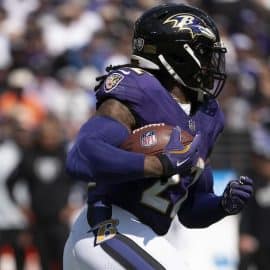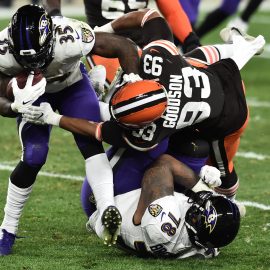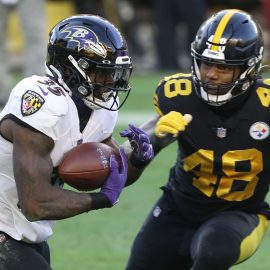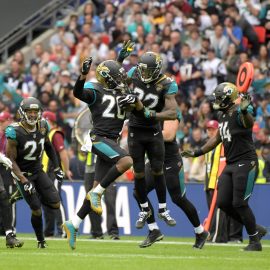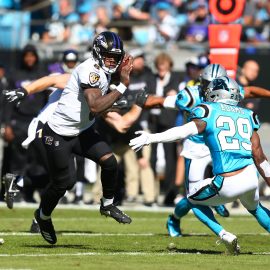I won’t belabor this, since the Ravens themselves have decided to move on and let it go…
But as John Harbaugh and Ozzie Newsome fly down to Mobile for Senior Bowl scouting duties, and the Ravens players clean out their lockers, here is one last look at the technicality of a play which I think the refs missed and the NFL Review Booth was precluded from taking a procedural jurisdiction of:
With less than 30 seconds to go in the AFC title game and the Baltimore Ravens down by three, quarterback Joe Flacco threw a back-shoulder pass to the right corner of the end zone. The pass was ruled incomplete, knocked out of his receiver’s hands by a Patriots cornerback in the end zone. In the blur of real-time action, CBS’ Jim Nantz shouted that “it was Sterling Moore who took it away from Torrey Smith.” A moment later, Nantz corrected himself: The guy who “lost” the ball was Lee Evans.
On CBS’ replay, with the players’ movements slowed down to a comprehensible speed, the order of operations became clearer. In super slo-mo, you can see Evans cradle the ball, land on his right foot, and get the ball raked away as his left foot touches the ground. According to the NFL rule, “If a player controls the ball while in the end zone, both feet, or any part of his body other than his hands, must be completely on the ground before losing control, or the pass is incomplete.” If you apply that definition, the replay revealed that Evans kind of caught the ball for maybe a touchdown …
In the case of the Evans catch/non-catch, the league’s replay apparatchiks chose not to initiate a review. I’d like to think that the guys upstairs decided not to buzz down because the slow-motion replays were so philosophically troubling. In real time, it looked like it maybe wasn’t a touchdown. When you slowed it down to a speed that humans don’t actually move, it looked like it could have been a catch. Do we get to a deeper truth by scrutinizing a play one frame at a time, or is it fairer to evaluate the action at full speed? What does it mean for one’s feet to “be completely on the ground”? And what is possession, anyway? Also, can we please rehash the metaphysics of that earlier Ravens touchdown, when Torrey Smith reached across a goal line that extends all the way around the world?
On NFL.com, they labeled the throw that Sterling Moore (possibly illegally) jarred out as “Evans’ dropped pass.” On the CBS post-game show, Shannon Sharpe said that “in the National Football League, professional football players … you’ve got to make this play…” “He relaxed,” Sharpe added, noting a change in Evans’ demeanor during the millisecond before Moore’s right arm came down on him like a guillotine. If Lee Evans is able to relax during that less-than-a-moment, I’m guessing he has little trouble falling asleep on an airplane.
Sharpe found his own kind of certainty in that slow-motion replay. So did Phil Simms. “That was an incomplete pass,” the CBS color man declared authoritatively after watching Evans and Moore come together, slowly, in the end zone. And so too, surprisingly, did Lee Evans, when reporters asked him if it was a catch. “Obviously it wasn’t,” he said. “It was an opportunity to go to the Super Bowl, and I let it go.”
But Lee Evans knew less than anyone else about what had happened to him in the corner of the Patriots’ end zone. A football game moves too fast for the guys who are playing it to know what’s happening to them or around them. Dozens of times each season, a player pleads with his coach to challenge a call that should not be challenged: He thinks he caught the ball, but it really hit the ground. In this case, Evans thought he didn’t catch a ball that he might have actually caught. The one thing the Ravens receiver did grasp correctly was the post-game narrative. Like everyone else, he thought he’d cost his team a shot at the Super Bowl. No matter how much you slowed down the replay, that story wasn’t going to change.
But if you check out the following video links to the play courtesy of Slate.com, you may see why I consider Evans “non-catch” a catch…and a reception for a TD.
THE LEE EVANS “CATCH”
One of the many hot topics in the wake of Sunday’s conference championship games is Lee Evans non-catch at the end of regulation in the Pats-Ravens game. Over on Slate, Josh Levin has a good analysis of the catch. Levin seems to think that a strict application of the NFL rule on touchdown catches suggests that Evans did make the catch. Here’s the language he looks at:
Item 3: End Zone Catches. If a player controls the ball while in the end zone, both feet, or any part of his body other than his hands, must be completely on the ground before losing control, or the pass is incomplete.
Note: In the field of play, if a catch of a forward pass has been completed, after which contact by a defender causes the ball to become loose before the runner is down by contact, it is a fumble, and the ball remains alive. In the end zone, the same action is a touchdown, since the receiver completed the catch beyond the goal line prior to the loss of possession, and the ball is dead when the catch is completed.
Okay, so the thing you have to determine is—did Evans complete the catch? I say he did by the strictest interpretation of the end-zone rule. This assumes he had both feet down with possession of the ball prior to the late strip by Sterling Moore. Since Evans backpedaled into the endzone, I say he should get credit for two (and possibly three) feet down— nobody seems to be looking at his first backpedal step as he caught the ball going away from the defender.
And if Evans had control of the ball with both feet established inside the end-zone, that ball was a TD the moment it crossed the plane of the goal line and rested in his hands, which by my count was a solid 0.3 seconds.
At that point, no defender has the right to touch let alone strip the ball from the receiver. By NFL rule, that ball is untouchable.
You might as well be able to tackle a guy who is in the act of spiking a ball after a TD, dislodge the spike, and call that a fumble!
I’m sorry, but based on the evidence I’ve reviewed, Lee Evans scored a TD on that play…and not even Lee Evans knows the rules well enough to appreciate it.
Levin’s article does get at another interesting issue; the limitations of instant replay and the metaphysics of football. Defining a catch is hard stuff: when slowed down, some valid catches look questionable and some questionable catches look valid. This is true of a lot of plays. On close examination, what was once clear looks murky; this is a problem for the NFL and one that’s exacerbated by replay.
The only reason I’m obsessing about this is some day (and that day may never come) a non-call like this is going to affect the outcome of another NFL game…and it better not cost another worthy team a championship.
Add The Sports Daily to your Google News Feed!

